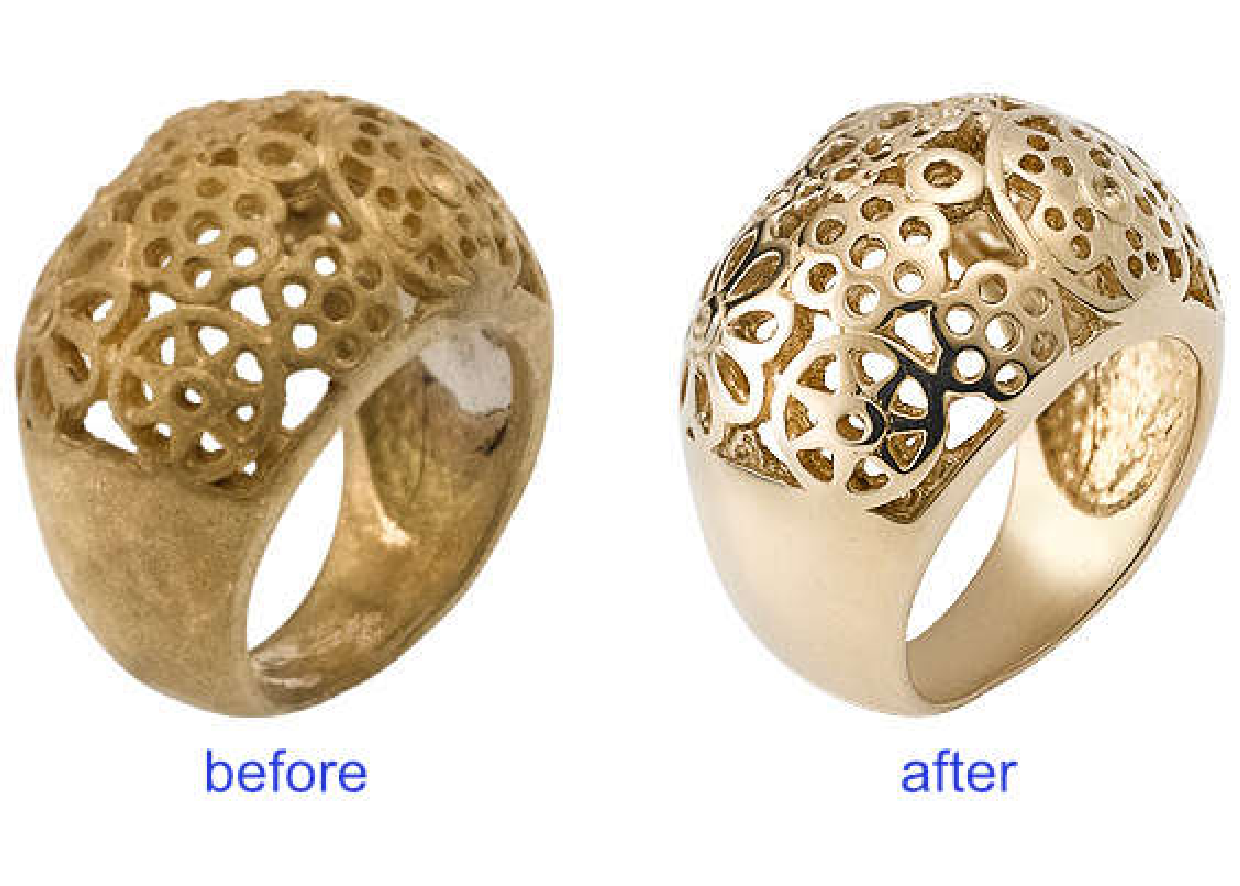What is an Electro Polishing Machine?
 Transforming raw metals into exquisite jewelry pieces involves a myriad of processes, each contributing to the final gleaming masterpiece. Among these techniques, electro-polishing stands out as a fascinating method, bringing out the luster and beauty of metals like never before. In this blog, we delve into the intricacies of electro-polishing jewelry machines, unraveling the magic behind their brilliance.
Transforming raw metals into exquisite jewelry pieces involves a myriad of processes, each contributing to the final gleaming masterpiece. Among these techniques, electro-polishing stands out as a fascinating method, bringing out the luster and beauty of metals like never before. In this blog, we delve into the intricacies of electro-polishing jewelry machines, unraveling the magic behind their brilliance.1. Understanding Electro-Polishing:
Electro-polishing is a precise electrochemical process used to remove surface material from a metal object, resulting in a smooth, shiny finish. Unlike traditional polishing methods, which can be labor-intensive and inconsistent, electro-polishing offers uniformity and control over the final product's appearance.
2. How Electro-Polishing Jewelry Machines Work:
These machines consist of specialized tanks filled with electrolyte solutions and anodes made of inert materials like platinum or stainless steel. The jewelry pieces to be polished are submerged in the electrolyte bath and connected to the machine's power source, forming an electric circuit.
As electric current passes through the circuit, metal ions dissolve from the jewelry's surface, effectively smoothening out imperfections, burrs, and irregularities. The process occurs at a microscopic level, ensuring that even intricate designs retain their detail and integrity.
3. Advantages of Electro-Polishing Jewelry Machines:
- Enhanced Surface Finish: Electro-polishing delivers a mirror-like surface finish, free from scratches, pits, or other blemishes. This immaculate appearance adds value and allure to the jewelry pieces.
- Improved Corrosion Resistance: By removing surface imperfections, electro-polishing creates a passive layer on the metal's surface, enhancing its resistance to corrosion and tarnishing. This is particularly crucial for jewelry items exposed to moisture or harsh environments.
- Precise Control: Jewelers can fine-tune the electro-polishing parameters such as current density, temperature, and electrolyte composition to achieve desired results consistently. This level of control ensures uniformity across batches and meets strict quality standards.
- Preservation of Details: Unlike mechanical polishing methods that may round off sharp edges or obscure intricate patterns, electro-polishing preserves the intricate details of jewelry designs, maintaining their artistic integrity.
- Eco-Friendly Solution: Electro-polishing produces minimal waste compared to traditional polishing techniques, making it a more environmentally sustainable option. Additionally, many electrolyte solutions used in the process are biodegradable, further reducing its ecological footprint.
 4. Applications of Electro-Polishing in Jewelry Making:
4. Applications of Electro-Polishing in Jewelry Making:
- Gold and Silver Jewelry: Electro-polishing is widely employed in refining gold and silver jewelry, imparting a brilliant shine to rings, necklaces, earrings, and bracelets.
- Stainless Steel Jewelry: Stainless steel jewelry items benefit from electro-polishing to remove surface contaminants, weld discoloration, and enhance their overall aesthetics.
- Precious Gemstone Settings: Electro-polishing can be selectively applied to jewelry settings to polish metal surfaces around precious gemstones without affecting the stones' integrity or brilliance.
5. Considerations for Jewelry Designers and Manufacturers:
- Material Compatibility: While electro-polishing is suitable for a wide range of metals, not all alloys may respond favorably to the process. It's essential for designers to select metals compatible with electro-polishing to achieve optimal results.
- Design Complexity: Intricate designs with recesses or tight crevices may pose challenges during electro-polishing. Designers should consider simplifying complex features or incorporating alternative finishing techniques for such pieces.
- Post-Polishing Treatments: Depending on the desired finish and metal type, jewelry pieces may require additional treatments such as buffing, plating, or protective coatings after electro-polishing to enhance durability and aesthetic appeal.
6. Future Trends and Innovations:
- Automation and Robotics: With advancements in automation technology, electro-polishing processes are becoming more streamlined and efficient. Robotic systems can handle repetitive tasks with precision, reducing manual labor and enhancing production throughput.
- Customization Capabilities: Electro-polishing machines equipped with advanced software allow for customizable finishing profiles tailored to specific jewelry designs or customer preferences. This flexibility enables jewelry makers to offer personalized products with impeccable finishes.
- Sustainable Practices: The jewelry industry is increasingly embracing sustainability initiatives, and electro-polishing aligns well with this ethos due to its minimal environmental impact and efficient resource utilization. Future innovations may focus on further reducing energy consumption and waste generation in electro-polishing processes.
Electro-polishing jewelry machines epitomize the marriage of technology and craftsmanship, elevating the art of jewelry making to new heights of precision and beauty. As designers and manufacturers continue to innovate and refine these processes, we can expect to see even more stunning jewelry creations that dazzle with their flawless finishes and timeless elegance.
These machines consist of specialized tanks filled with electrolyte solutions and anodes made of inert materials like platinum or stainless steel. The jewelry pieces to be polished are submerged in the electrolyte bath and connected to the machine's power source, forming an electric circuit.
As electric current passes through the circuit, metal ions dissolve from the jewelry's surface, effectively smoothening out imperfections, burrs, and irregularities. The process occurs at a microscopic level, ensuring that even intricate designs retain their detail and integrity.
3. Advantages of Electro-Polishing Jewelry Machines:
- Enhanced Surface Finish: Electro-polishing delivers a mirror-like surface finish, free from scratches, pits, or other blemishes. This immaculate appearance adds value and allure to the jewelry pieces.
- Improved Corrosion Resistance: By removing surface imperfections, electro-polishing creates a passive layer on the metal's surface, enhancing its resistance to corrosion and tarnishing. This is particularly crucial for jewelry items exposed to moisture or harsh environments.
- Precise Control: Jewelers can fine-tune the electro-polishing parameters such as current density, temperature, and electrolyte composition to achieve desired results consistently. This level of control ensures uniformity across batches and meets strict quality standards.
- Preservation of Details: Unlike mechanical polishing methods that may round off sharp edges or obscure intricate patterns, electro-polishing preserves the intricate details of jewelry designs, maintaining their artistic integrity.
- Eco-Friendly Solution: Electro-polishing produces minimal waste compared to traditional polishing techniques, making it a more environmentally sustainable option. Additionally, many electrolyte solutions used in the process are biodegradable, further reducing its ecological footprint.
 4. Applications of Electro-Polishing in Jewelry Making:
4. Applications of Electro-Polishing in Jewelry Making:- Gold and Silver Jewelry: Electro-polishing is widely employed in refining gold and silver jewelry, imparting a brilliant shine to rings, necklaces, earrings, and bracelets.
- Stainless Steel Jewelry: Stainless steel jewelry items benefit from electro-polishing to remove surface contaminants, weld discoloration, and enhance their overall aesthetics.
- Precious Gemstone Settings: Electro-polishing can be selectively applied to jewelry settings to polish metal surfaces around precious gemstones without affecting the stones' integrity or brilliance.
5. Considerations for Jewelry Designers and Manufacturers:
- Material Compatibility: While electro-polishing is suitable for a wide range of metals, not all alloys may respond favorably to the process. It's essential for designers to select metals compatible with electro-polishing to achieve optimal results.
- Design Complexity: Intricate designs with recesses or tight crevices may pose challenges during electro-polishing. Designers should consider simplifying complex features or incorporating alternative finishing techniques for such pieces.
- Post-Polishing Treatments: Depending on the desired finish and metal type, jewelry pieces may require additional treatments such as buffing, plating, or protective coatings after electro-polishing to enhance durability and aesthetic appeal.
6. Future Trends and Innovations:
- Automation and Robotics: With advancements in automation technology, electro-polishing processes are becoming more streamlined and efficient. Robotic systems can handle repetitive tasks with precision, reducing manual labor and enhancing production throughput.
- Customization Capabilities: Electro-polishing machines equipped with advanced software allow for customizable finishing profiles tailored to specific jewelry designs or customer preferences. This flexibility enables jewelry makers to offer personalized products with impeccable finishes.
- Sustainable Practices: The jewelry industry is increasingly embracing sustainability initiatives, and electro-polishing aligns well with this ethos due to its minimal environmental impact and efficient resource utilization. Future innovations may focus on further reducing energy consumption and waste generation in electro-polishing processes.
Electro-polishing jewelry machines epitomize the marriage of technology and craftsmanship, elevating the art of jewelry making to new heights of precision and beauty. As designers and manufacturers continue to innovate and refine these processes, we can expect to see even more stunning jewelry creations that dazzle with their flawless finishes and timeless elegance.


Comments
Leave A Reply
Your email address will not be published.